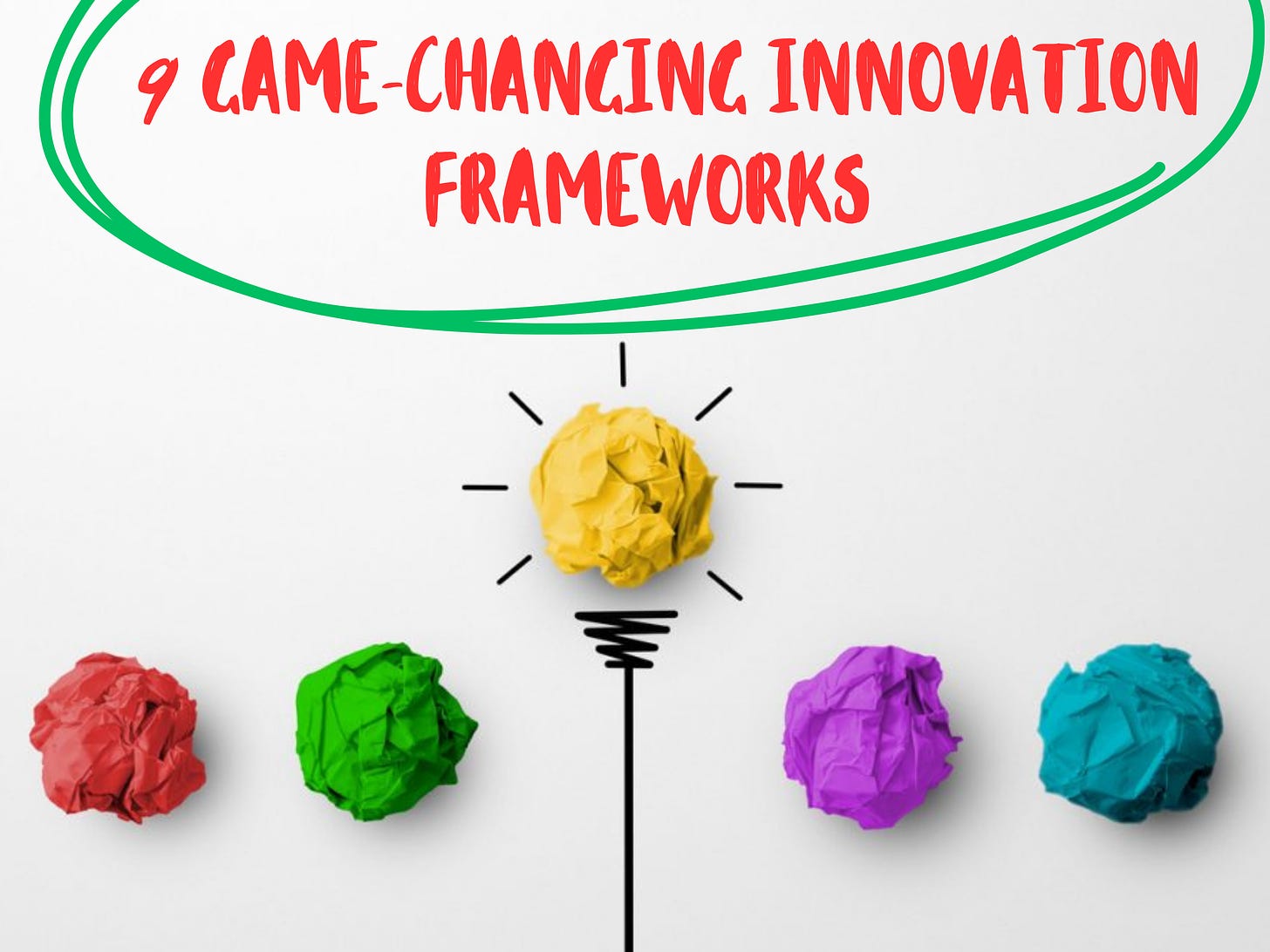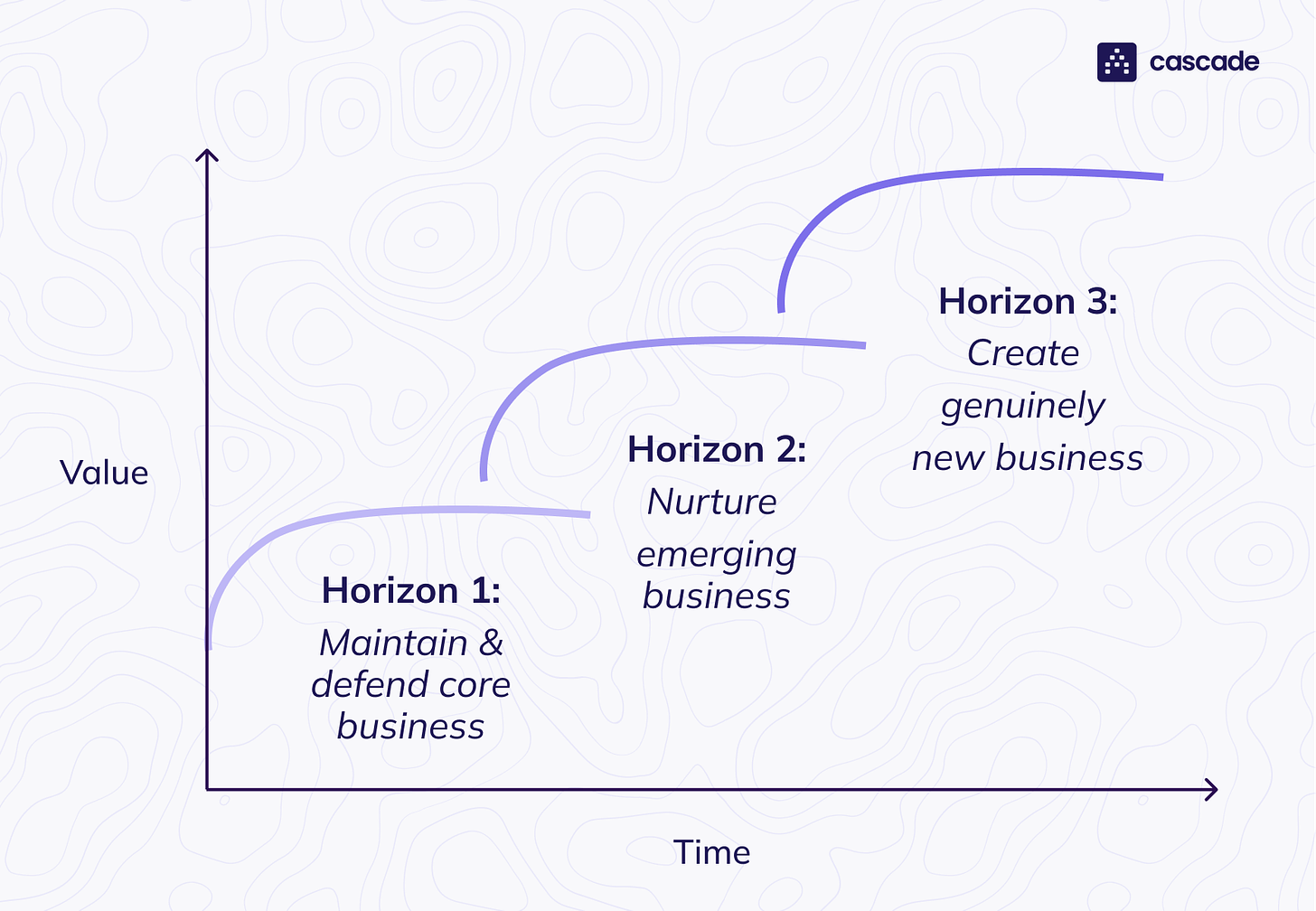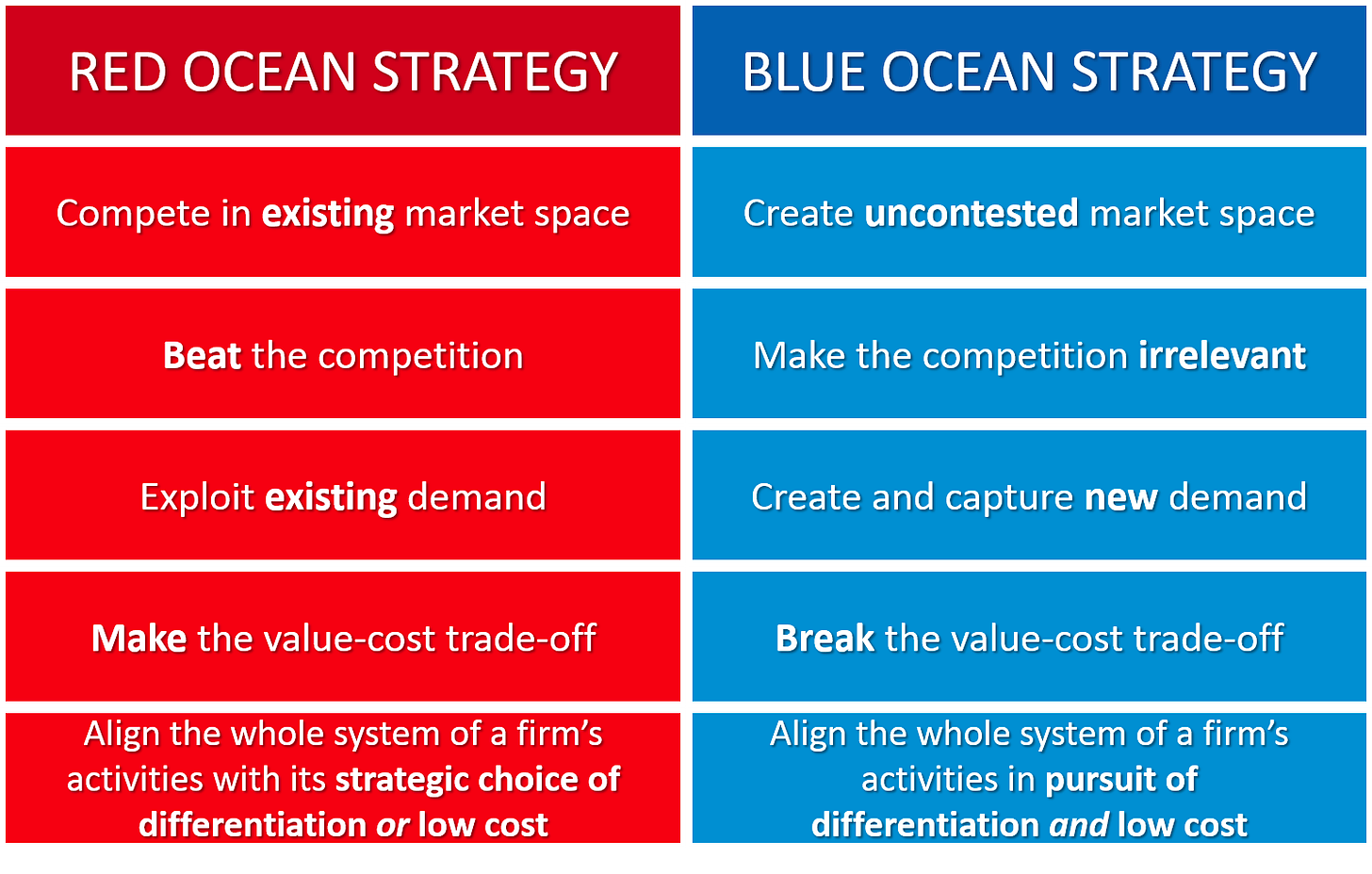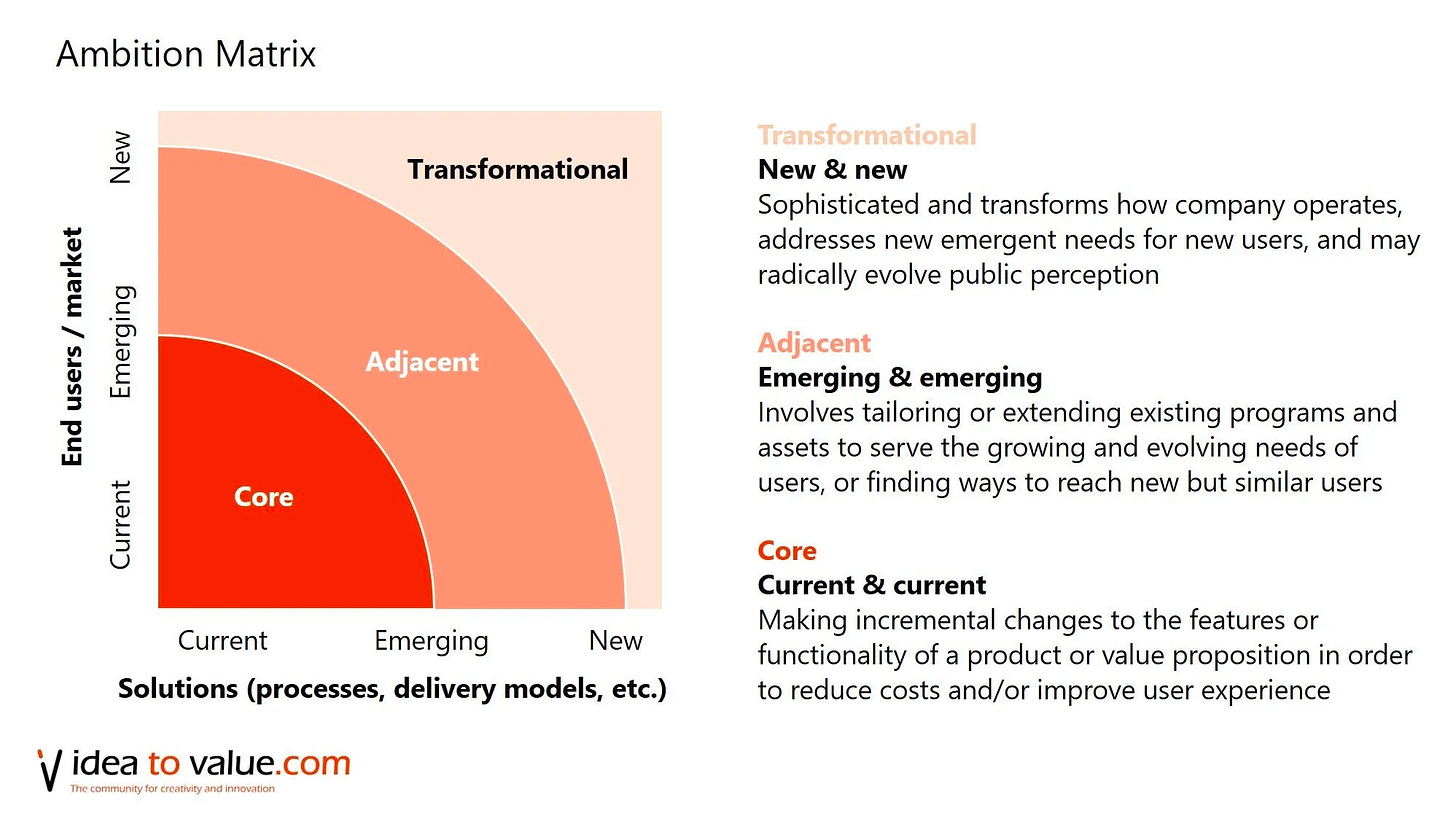Quote
"Alone we can do so little, together we can do so much." - Helen Keller
💯 Framework // Concept // Mental Model
As a product manager, developing innovative products and features is a crucial part of the job. But with so many frameworks and methodologies out there, it can be tricky to know where to start or which approach to take.
In this post, we’ll explore 9 key innovation frameworks that every product team should be familiar with. Mastering these frameworks can help you drive innovation, spur creativity, and deliver more value to users.
1. Design Thinking 🤔
Design thinking is a human-centered approach to innovation that puts the user front and center. The goal is to develop a deep empathy and understanding of user needs before ideating and prototyping solutions.
Design thinking provides a structured framework for innovation with five key phases:
Empathize - Gather insights into user needs through interviews, observations, and immersion. Really understand the problem you are trying to solve. 👥
Define - Process your insights to define the core problems and needs. Reframe the problem into a problem statement or design challenge. 📝
Ideate - Brainstorm solutions and ideas to address the problem statement. Think broadly without judging initial ideas. 💡
Prototype - Build rough prototypes to test ideas with users. Prototypes should be quick and disposable. 🏗️
Test - Gather feedback by testing prototypes with real users. Iterate based on insights gathered. 🧪
Design thinking is useful when you need to take an exploratory approach to innovation. It is excellent for tackling problems that are ill-defined or ambiguous. By starting from user insights, design thinking can uncover innovative solutions that truly address user needs.
Key resources:
2. Lean Startup ⏱
Lean startup is a methodology for rapidly experimenting and iterating new product concepts. The core idea is to build and test minimum viable products (MVPs) to validate key assumptions and ideas through real user feedback.
The build-measure-learn loop is the foundation of lean startup:
Build - Rapidly build an MVP with just enough features to test the idea 🏗️
Measure - Release the MVP to start collecting data and learning from users 📊
Learn - Process insights from the MVP to determine the next steps. Pivot or proceed. 🤔
Lean startup helps product teams fail fast and de-risk innovation. By testing rough MVPs early with users, teams can gather insights and iterate quickly without over-investing upfront. This works well for building brand new products with lots of unknowns.
Key resource:
3. Three Horizon Framework
The three horizon framework provides a model for balancing different types of innovation based on their timeline and potential. It categorizes innovation into three “horizons”:
Horizon 1 - Optimizing existing products, improving core business. Short-term returns. 💰
Horizon 2 - Evolve into adjacent markets, opportunities, and customers. Medium-term returns. 💰💰
Horizon 3 - Create transformative or disruptive innovations. Long-term returns. 💰💰💰
This framework pushes product teams to diversify their innovation efforts across all three horizons. Horizon 1 improvements bring in revenue today, while Horizon 3 innovations will transform the future. Horizon 2 provides the bridge between the two.
Balancing short, medium and long-term innovation ensures your product pipeline is driving incremental and disruptive innovation in parallel.
4. Blue Ocean Strategy 🌊
Blue ocean strategy is about creating uncontested market space ripe for growth. Instead of fighting competitors directly (a “red ocean”), blue ocean strategy seeks to make the competition irrelevant.
The framework helps teams systematically pursue “blue oceans” of uncontested markets in two ways:
Identify - Find untapped markets where you can create and capture new demand. Often these are between, across or new industry categories.
Innovate - Develop innovative products, services and business models that cater to this new space. Focus on differentiation and unique value rather than competing directly.
Product teams can apply blue ocean strategy to break out of crowded markets saturated with competitors. It provides a lens for finding pockets of demand that are unfulfilled or undiscovered.
Key resource:
5. Jobs-to-be-Done Framework 💼
Jobs-to-be-Done (JTBD) is a framework for understanding the higher purpose that customers are hiring products or services to fulfill. The core premise is that people don’t simply buy products; they pull them into their lives to get a job done.
The framework pushes product teams to think beyond demographics and focus on the functional, social and emotional dimensions that make up the “jobs” people want to accomplish.
Using the JTBD framework, product managers can:
Uncover - Deeply understand the full complexity of the job customers need done. Observe, interview, empathize. 🕵️
Align - Map product features and attributes to the functional, social and emotional dimensions of the job.
Create - Determine which new features or offerings would help the customer get the job done better and more completely. 💡
JTBD provides a new lens on customer needs and insights that can spur innovative thinking. It is extremely useful for developing compelling value propositions that closely align with the jobs customers want to get done.
Key resource:
6. Disruptive Innovation Theory 💥
Disruptive innovation describes how new entrants are able to challenge incumbents by targeting overlooked segments or attacking from the low end of the market. These disruptors start by offering simpler, more affordable innovations that may appear unimpressive at first. But as technology improves, disruption starts climbing “upmarket” eventually overtaking incumbents.
Think digital cameras disrupting Kodak. Or cloud computing disrupting on-premise hardware and software vendors.
The theory emphasizes how disruptive innovations are initially dismissed by incumbents because the financial opportunity appears small and limited. But they eventually are able to disrupt the status quo.
Product teams should seek disruptive opportunities and attack established markets from new angles. Disrupt before you are disrupted!
Key resource:
7. 10x Thinking 🚀
10x thinking challenges product teams to pursue solutions that are 10 times (or exponentially) better, rather than aiming for incremental improvements.
This forces product managers to radically rethink problems instead of marginally enhancing existing solutions. 10x thinking expands your innovation horizons in order to:
Rethink business models, product categories, and industry assumptions 💭
Redefine how value is delivered and problems are solved ✨
Remove unnecessary complexity and barriers 🚫
Leverage new technology, materials, infrastructure ⚙️
Unlock new sources of supply, demand, capital, ideas 🔓
10x thinking requires zooming out from existing solutions to take a broader view. It pushes teams to combine breakthrough technology with innovative business models.
While 10x ideas seem unrealistic at first, the goal is to spur creative thinking beyond small iterations. Reaching for a 10x improvement often leads to outsized innovation, even if you fall slightly short.
8. Innovation Ambition Matrix 🎯
The Innovation Ambition Matrix is a strategic tool used to categorize and prioritize innovation efforts within an organization. It provides a visual framework to align teams on where to invest time, effort, and resources. The matrix is broken down into three categories: core, adjacent, and transformational innovations, each representing different levels of ambition and risk.
2. Structure and Categories of the Matrix:
Core Innovations (70%): These are enhancements to existing products or services. They are lower-risk and align with the current business model, focusing on improving what's already offered.
Adjacent Innovations (20%): This middle layer represents more significant changes that might connect existing products to new customers or new products to existing customers. It's a moderate-risk category, usually building on what's already there but still feels fresh and new.
Transformational Innovations (10%): The most ambitious category, focusing on entirely new products, services, or markets. These are high-risk but can yield significant rewards if successful.
The balance of 70-20-10 between these categories is often recommended, allowing for consistent improvements while still investing in groundbreaking ideas
9. Crowdsourcing 👥
Crowdsourcing involves engaging a large, diverse group of people to contribute ideas, feedback, solutions, or participation. Popular examples include open innovation programs, idea jams, hackathons, public contests, surveys, and online suggestion boxes.
For product innovation, crowdsourcing provides several key benefits:
Access the wisdom of the crowd 🧠
Increase diversity of perspectives and ideas 💡
Tap into external talent, skills, and creativity 💪
Give customers a voice in shaping offerings 🗣️
Accelerate idea generation and selection ⚡️
Crowdsourcing can complement internal innovation efforts by expanding the pool of concepts, designs, and solutions to choose from. It also fosters engagement and co-creation with customers.
In Summary
Innovation comes in all shapes and sizes. As a product manager, having a diverse toolkit of innovation frameworks is invaluable for tackling problems from multiple angles.
The 9 frameworks provide lenses for rethinking user needs, exploring undiscovered markets, leveraging new technologies, and delivering 10x value. Mastering these frameworks helps build well-rounded product innovation skills.
While they represent very different approaches, each framework provides a window into how product innovation can create substantial new value for customers and businesses. Applying even one of these lenses can lead to new insights that spark creative solutions.
Use these frameworks to expand your perspective, break free of old assumptions, and power innovation on your product teams. What new possibilities will you unlock next?
😎 Meme
I spend a lot of time researching on topics to give you the best content, If you like my work please like and share it with others. If you have any feedback for me or want me to write on other topics please leave a comment below. Thanks for your continued support.
✌️ It only takes one minute to complete the Net Promoter Score survey for this Post, and your feedback helps me to make each Post better.
https://siddhartha3.typeform.com/to/AmQxc4Uk
If you liked reading this, feel free to click the ❤️ button on this post so more people can discover it on Substack 🙏








![Image - 252667] | What People Think I Do / What I Really Do | Know Your Meme Image - 252667] | What People Think I Do / What I Really Do | Know Your Meme](https://substackcdn.com/image/fetch/w_1456,c_limit,f_auto,q_auto:good,fl_progressive:steep/https%3A%2F%2Fsubstack-post-media.s3.amazonaws.com%2Fpublic%2Fimages%2Fac9eca57-b72a-493e-b3f9-596c3b6149a0_720x500.jpeg)
Wow that's a great summary of different approaches. :) Some I knew some were interesting to learn.